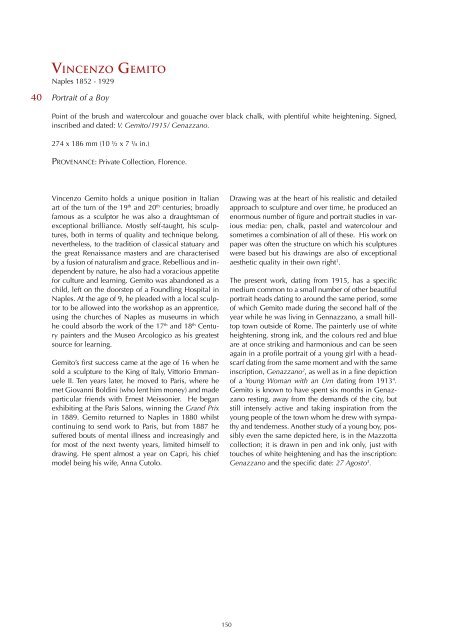You also want an ePaper? Increase the reach of your titles
YUMPU automatically turns print PDFs into web optimized ePapers that Google loves.
Vincenzo Gemito<br />
Naples 1852 - 1929<br />
40<br />
Portrait of a Boy<br />
Point of the brush and watercolour and gouache over black chalk, with plentiful white heightening. Signed,<br />
inscribed and dated: V. Gemito/1915/ Genazzano.<br />
274 x 186 mm (10 ½ x 7 ¼ in.)<br />
Provenance: Private Collection, Florence.<br />
Vincenzo Gemito holds a unique position in Italian<br />
art of the turn of the 19 th and 20 th centuries; broadly<br />
famous as a sculptor he was also a draughtsman of<br />
exceptional brilliance. Mostly self-taught, his sculptures,<br />
both in terms of quality and technique belong,<br />
nevertheless, to the tradition of classical statuary and<br />
the great Renaissance masters and are characterised<br />
by a fusion of naturalism and grace. Rebellious and independent<br />
by nature, he also had a voracious appetite<br />
for culture and learning. Gemito was abandoned as a<br />
child, left on the doorstep of a Foundling Hospital in<br />
Naples. At the age of 9, he pleaded with a local sculptor<br />
to be allowed into the workshop as an apprentice,<br />
using the churches of Naples as museums in which<br />
he could absorb the work of the 17 th and 18 th Century<br />
painters and the Museo Arcologico as his greatest<br />
source for learning.<br />
Gemito’s first success came at the age of 16 when he<br />
sold a sculpture to the King of Italy, Vittorio Emmanuele<br />
II. Ten years later, he moved to Paris, where he<br />
met Giovanni Boldini (who lent him money) and made<br />
particular friends with Ernest Meissonier. He began<br />
exhibiting at the Paris Salons, winning the Grand Prix<br />
in 1889. Gemito returned to Naples in 1880 whilst<br />
continuing to send work to Paris, but from 1887 he<br />
suffered bouts of mental illness and increasingly and<br />
for most of the next twenty years, limited himself to<br />
drawing. He spent almost a year on Capri, his chief<br />
model being his wife, Anna Cutolo.<br />
Drawing was at the heart of his realistic and detailed<br />
approach to sculpture and over time, he produced an<br />
enormous number of figure and portrait studies in various<br />
media: pen, chalk, pastel and watercolour and<br />
sometimes a combination of all of these. His work on<br />
paper was often the structure on which his sculptures<br />
were based but his drawings are also of exceptional<br />
aesthetic quality in their own right 1 .<br />
The present work, dating from 1915, has a specific<br />
medium common to a small number of other beautiful<br />
portrait heads dating to around the same period, some<br />
of which Gemito made during the second half of the<br />
year while he was living in Gennazzano, a small hilltop<br />
town outside of Rome. The painterly use of white<br />
heightening, strong ink, and the colours red and blue<br />
are at once striking and harmonious and can be seen<br />
again in a profile portrait of a young girl with a headscarf<br />
dating from the same moment and with the same<br />
inscription, Genazzano 2 , as well as in a fine depiction<br />
of a Young Woman with an Urn dating from 1913 4 .<br />
Gemito is known to have spent six months in Genazzano<br />
resting, away from the demands of the city, but<br />
still intensely active and taking inspiration from the<br />
young people of the town whom he drew with sympathy<br />
and tenderness. Another study of a young boy, possibly<br />
even the same depicted here, is in the Mazzotta<br />
collection; it is drawn in pen and ink only, just with<br />
touches of white heightening and has the inscription:<br />
Genazzano and the specific date: 27 Agosto 3 .<br />
150
















